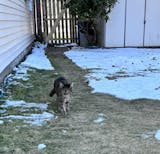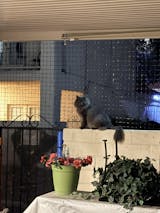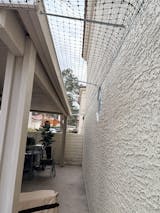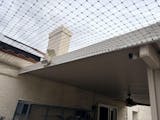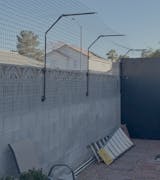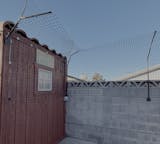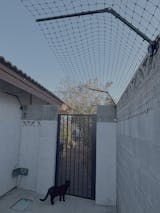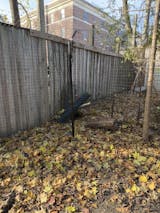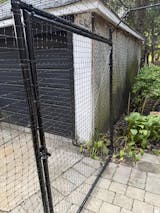
Choosing the right solution for creating a safe outdoor space for your cat can be riddled with options and misinformation. Some suggested choices are catios, kennels, yard fencing, invisible fencing, shock collars, and more. Then, factors such as cost, ease of installation, effectiveness, and even plain old personal preference, add to your options. Picking the right fit for your fur buddy can be a daunting task, to say the least.
One of the more heavily marketed options (and often misunderstood) is the radio fence. The radio fence is also known as a wireless fence, electric pet fence, invisible cat/dog fence, or underground fence. It is a popular pet fence commonly used to contain dogs and is also marketed for cat use. The fence uses a radio broadcast with an electric collar to shock the animal if they attempt to leave the containment area.
A Note About Electric Shock to Animals
Electric shock is unlike any naturally occurring pain an animal will encounter, and its use as a training tool is controversial. For the purpose of discussing the effectiveness ofinvisible fence cat collars as pet containment, this article will not cover the ethics of intentionally inflicting pain on an animal as a means of changing their behavior.
How Does an Invisible Cat Fence Work?
Invisible pet fences use a wire, typically buried a few inches underground, to broadcast an FM radio signal with a total range of several feet in all directions from the wire. The signal weakens further from the wire but is still detectable several feet from it. The FM transmitting wire runs in a loop that follows the perimeter where you want the animal contained.
For the invisible cat fence to work, the animal must wear a special “shock” collar that detects an FM signal. When the invisible fence cat collar is within several feet of the wire in the “weak signal” area, an alarm will beep to alert the animal that proceeding will mean a shock. The signal to shock is triggered once the collar enters the “strong” FM signal within a few feet of the wire. In principle, an animal is trained to understand that the beep noise is a warning of the impending shock and should not proceed forward.
These fences can form an effectively invisible perimeter for containing companion animals in the right circumstances. The “right circumstances” come down to the setting of the containment area and the temperament and trainability of the animal.
Requirements of Invisible Cat Fences

Since no physical barriers are involved, proper and thorough animal training is essential for the success of invisible fences. The system's effectiveness completely depends on training the animal well, which can take weeks or even months.
Typically, owners mark the “warning beep” perimeter with a series of small flags. Then, they train the animal to stay within the area delineated by the line of flags. The manufacturers of invisible fence cat collar systems provide recommended training procedures.
A quiet backyard is the ideal setting for this system. Conversely, a busy area with lots of traffic and pedestrians (or worse, pedestrians walking dogs) could prove too enticing, scary, or distracting for even a well-trained animal to stay within the containment area. Other factors possible in any setting (including an ideal setting), such as a loud car accident, sirens, or other loud noises like gunfire or thunder, could cause panic in an otherwise well-trained animal.
Disadvantages of Electric Pet Fences
A major problem with invisible cat fence systems is that it does not affect other animals or people. Other animals and people can cross the perimeter at will. The radio fence does nothing to protect your pet from anything entering the containment area. A well-trained pet must stay within the fence perimeter if a squirrel or neighbor cat wanders in!
Invisible fence cat collars can be risky in areas with foxes, coyotes, fisher cats, bobcats, cougars, other predators, and neighboring cats/dogs since nothing keeps these animals from entering the perimeter. The possibility of interacting with wild animals which can spread bacteria and viruses and potentially inflict physical harm is ever-present.
What Happens If Your Cat Leaves the Containment Area?

An excited or panicked pet may ignore the collar's beep and run through the “strong signal” shock area. Once out of the “strong field” area, the shock stops. Now the cat is outside the invisible fence. It is important to note that the animal will encounter the same warning beep as it would inside the radio fence when it approaches the “warning beep” area from outside the perimeter.
The animal was shocked by leaving the system’s perimeter, so it received a strong reminder of what the warning beep meant. Essentially the animal's training will tell it NOT to go back into the radio fence because it will get shocked. The re-entry shock is one of the most significant shortcomings of invisible fence cat collars.
Some pet owners have had good success with invisible cat fence systems. That said, it is not a physical barrier. It does not keep other animals out nor contain an overly excited, frightened, or panicked pet. Invisible fences, in particular, are less likely to be effective due to the difficulty in training animals, and many people tend to have multiple pets. Training pets and keeping all the collars in working order can be overwhelming. Batteries are also an issue as many of these systems require constant replacement to keep the invisible fence in working order.
The Bottom Line
Purrfect Fence is a supporter of humane containment options for all animals. We offer innovative physical barrier fences for cats and dogs that allow your pet to roam freely in designated spaces without needing radio shock collars. Our fences receive recognition as the leader in keeping pets safe and happy outdoors.
Are you considering an invisible fence for your cat? If you already have a traditional fence installed, look into getting our Existing Cat Fence Topper. If you are looking to build a cat barrier from the ground up, consider our Freestanding Cat Fence System. Gain the benefits only a physical barrier can offer with an unmatched level of effectiveness vs. invisible fence cat collars.
If you have a dog that loves climbing over, getting through, or jumping your existing fence, consider our Dog Proofer Systems. Shop our humane fencing solutions to create a safe outdoor oasis and keep your beloved pet happy and contained.











